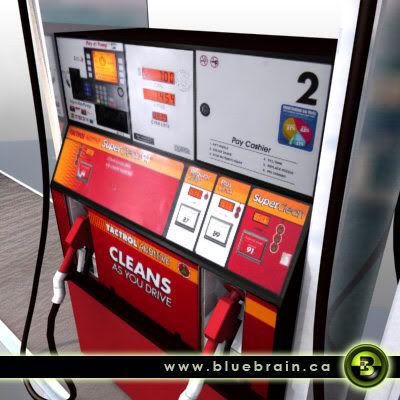Thursday, April 17, 2008
New Ride
April 12, 2008 is the last day I spent with my Ford Explorer Sport Trac, but was the first day I was able to spend with my new Chevy Cobalt.
Sunday, April 13, 2008
Fuel Fix

There are many strong visual arguments used in cartoons today that try to prove a point or give an opinion. This cartoon has strong arguments that show how “America is addicted to foreign oil”. The artist uses many rhetorical strategies in these cartoons to prove their point, some of those strategies include: cause and effect, analogy, and the use of ethos. All of these strategies and appeals put together give a strong argument as to whether America is really addicted to oil.
The cartoonists did this piece of work using the gray and black colors. It seems like it implies that America is in sort of bad times, and by that I mean with the fuel problems. It also kind of goes along with the look of the Statue of Liberty and that look is not good.
In this cartoon there are dark clouds of smoke in the background that seem to be representing burning oil pumps in Iraq. In the front of the image you have the Statue of Liberty lying on the ground next to a fuel pump injecting the fuel into her arm. The Statue of Liberty is really the focal point of this cartoon, but the burning oil pumps in the background just kind of give the cartoon a setting and that setting being the desert of Iraq.
In this illustration, you see that America is addicted to oil. In the top left hand corner the cartoonist put a quote from President Bush that says just that, “America is addicted to oil”. In the picture you also see the statue of liberty injecting fuel into her arm from a gas pump that you would see at a gas station, which this looks like what one might inject them if they were doing drugs. People do not usually incorporate drugs and fuel together, but in this cartoon, that is what it looks like the artist is doing exactly that. This is a form of analogy that argues that American’s use fuel like a drug addict uses drugs.
A good example of ethos stands out when talking about the appearance of the Statue of Liberty. She is really a symbol of America. She represents what America is and that is a truly free county. But the look of the Statue of Liberty is really quite bad in this picture; Her face looks horrible, she has spots all over her body from the injections, her teeth look bad, her eyes make her look like she is really high and even her crown is all broken. This is really the look of some people who are addicted to drugs. This cartoon is really implying that we as American’s are so dependant on oil that we will do almost anything to get it. We get the feeling that we need that fuel fix to get through our day, just as a drug addict has to light up a joint or snort a line of crack to get through the day.
The cartoonists did this piece of work using the gray and black colors. It seems like it implies that America is in sort of bad times, and by that I mean with the fuel problems. It also kind of goes along with the look of the Statue of Liberty and that look is not good.

In this cartoon there are dark clouds of smoke in the background that seem to be representing burning oil pumps in Iraq. In the front of the image you have the Statue of Liberty lying on the ground next to a fuel pump injecting the fuel into her arm. The Statue of Liberty is really the focal point of this cartoon, but the burning oil pumps in the background just kind of give the cartoon a setting and that setting being the desert of Iraq.

In this illustration, you see that America is addicted to oil. In the top left hand corner the cartoonist put a quote from President Bush that says just that, “America is addicted to oil”. In the picture you also see the statue of liberty injecting fuel into her arm from a gas pump that you would see at a gas station, which this looks like what one might inject them if they were doing drugs. People do not usually incorporate drugs and fuel together, but in this cartoon, that is what it looks like the artist is doing exactly that. This is a form of analogy that argues that American’s use fuel like a drug addict uses drugs.
A good example of ethos stands out when talking about the appearance of the Statue of Liberty. She is really a symbol of America. She represents what America is and that is a truly free county. But the look of the Statue of Liberty is really quite bad in this picture; Her face looks horrible, she has spots all over her body from the injections, her teeth look bad, her eyes make her look like she is really high and even her crown is all broken. This is really the look of some people who are addicted to drugs. This cartoon is really implying that we as American’s are so dependant on oil that we will do almost anything to get it. We get the feeling that we need that fuel fix to get through our day, just as a drug addict has to light up a joint or snort a line of crack to get through the day.

The overall appearance is just implying that America is in really bad shape and that it will take a lot of work to get back to good health. This cartoon plays with your emotions in a way that you never really thought that America could become so addicted to oil that we risk people’s lives in order to get what we want. But this cartoon is implying just that. As you can see in the middle of the fuel pump, the fuel that the Statue of Liberty is injecting into herself is fuel from Iraq and the numbers on the pump that would usually show the amount of fuel you are putting in and the amount in which you are pay. But in this cartoon the numbers that you are seeing above may represent the number of people that have died in the recent “war on terrorism” so that we can get our fuel. That also relates to the words that are in the box in the middle of the cartoon; they are saying that “the price of a fix keeps going up”. But if you break that down it is easier to interpret. The price in which they are talking about is the rising death toll of American Soldiers and even Iraqi citizens; the fix is the fuel and oil that we are consuming, and when it says that the price keeps going up is trying to say that we do not know how many more people will die just so that we as American’s can have our fuel fix. If you think about it a little more, you are paying in the $3.30 range for a gallon of gas and add that up if your tank is on empty, you are paying about $50 to fill up on fuel. Some people will go through a tank of gas every week or two. So in essence every American that purchases fuel is paying money for those deaths that are compiling on that fuel pump in the picture.

The cause and effect strategy is also used in this cartoon. As mentioned before about the price of a fix and the number of deaths, this is also cause and effect. The cause is that America needs their “fix” on fuel and the effect is that more people have to die in order to get that fix. The number of deaths is not really specified for Iraq, but it seems as if the illustrator is trying to say that it is just too great of a number and more are still dying over this.
Overall, this cartoon had strong arguments using different rhetorical strategies and appeals. The strongest strategy used in this cartoon was the analogy strategy. It was well represented throughout the cartoon. These strategies helped the illustrator to argue that America is addicted to oil and that it may take a long time for us American’s to realize that we have this problem.
Subscribe to:
Comments (Atom)